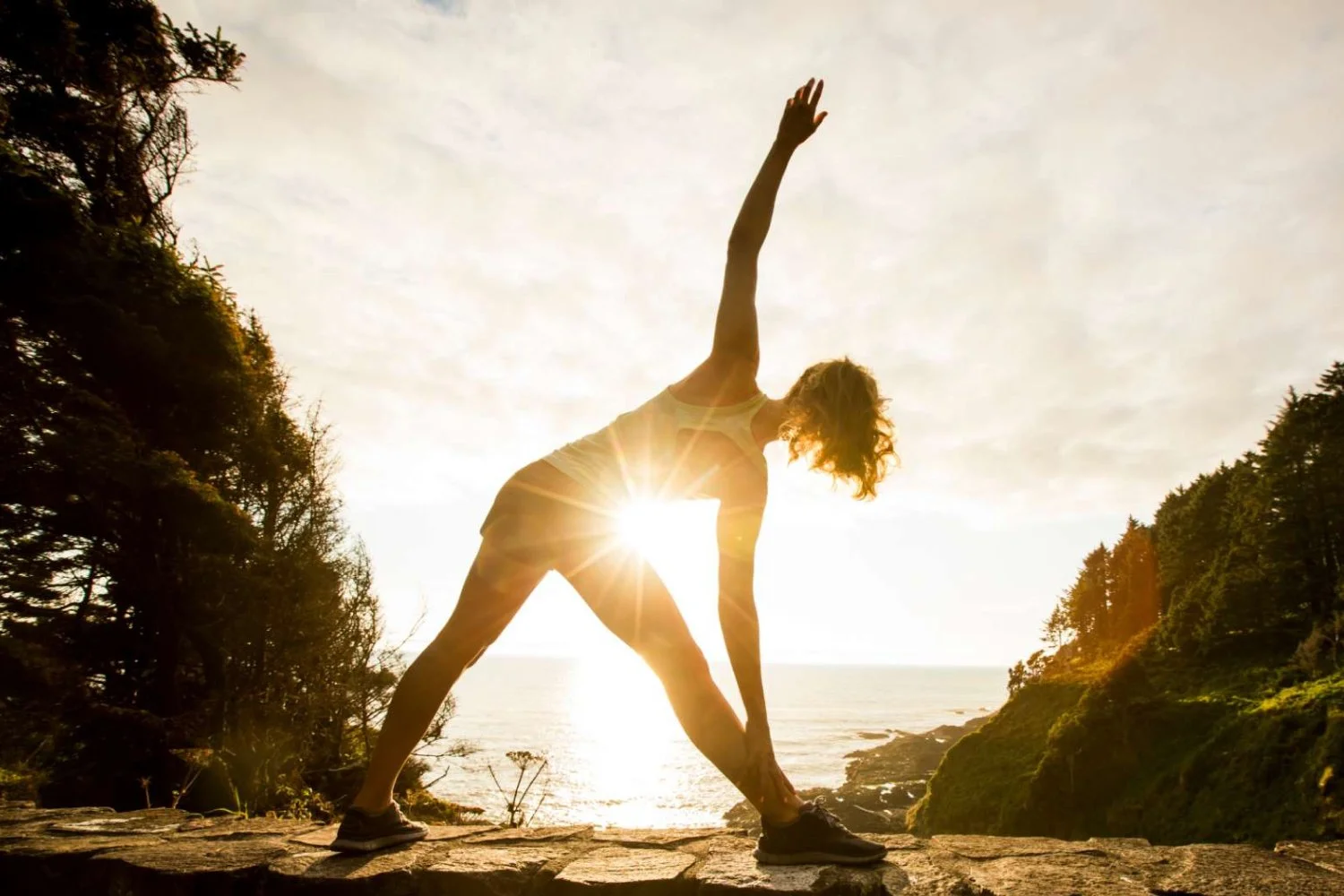The benefits of moving meditation and how to start practicing
Learn about the tradition of moving meditation and how you can start practicing. Plus, examples of movement meditation exercises and how they can benefit you.
In today’s fast-moving world, finding peace and balance is more important than ever. Moving meditation weaves together the calm of meditation with the energy of movement, creating a harmonious blend of wellbeing for your mind and body. Moving meditation is a unique approach to helping you achieve balance in the midst of commotion. Whether you’re looking to enhance your mental focus, improve your emotional health, or simply find a new way to relax, moving meditation might be the answer.
What is moving meditation?
Moving meditation is a way of bringing together movement and the focused mind. It’s a type of meditation that’s different from the traditional form, where you might sit quietly and remain still. In moving meditation, your body is active, but your mind is calm and centered.
When you practice moving meditation, you move with purpose, paying attention to each step and each breath. Being aware of how you are moving helps your mind to stay in the present moment. For example, you might notice the sensation of your feet touching the ground, the rhythm of your breath, or the sounds around you as you walk.
Moving meditation can be particularly helpful for those who find it hard to sit still and quiet their minds in traditional, seated meditation. Plus, it can be done almost anywhere—while walking in the park, doing gentle stretches at home, or even during everyday tasks like washing dishes.
Moving meditation is about connecting with yourself on a deeper level so you notice your thoughts and feelings without judgment. It is a practice that brings a sense of peace and clarity that can be beneficial in managing stress and improving overall wellbeing.
5 benefits of moving meditation
Moving meditation can have a positive impact on your overall health and wellbeing. The key is regular practice—the more you incorporate moving meditation into your routine, the more benefits you might notice.
1. Reducing stress
When you practice moving meditation, the focus on your movement and breathing can shift your attention away from your daily worries. It can give your mind a much-needed break and help your body to relax and release tension.
2. Controlling anxiety
If you often feel anxious, moving meditation can be a great way to manage these feelings in your daily life. The practice encourages you to stay in the present moment rather than dwelling on anxious thoughts about the past or future.
3. Enhancing emotional health
Moving meditation can support your emotional health by promoting a sense of inner peace and balance. It can help you become more aware of your emotions so you can respond to them in healthier ways.
4. Reducing age-related memory loss
Keeping your mind and body active is key to maintaining good cognitive health, especially as you age. Moving meditation combines physical activity with mental focus to help keep your brain sharp and reduce the risk of memory loss related to aging.
5. Improving sleep
Moving meditation can improve the quality of your sleep by helping your mind and body to relax. As you reduce stress and anxiety through meditation, you may find it easier to fall asleep and stay asleep throughout the night.
6 examples of moving meditation
Moving meditation can take many forms, each offering a unique way to connect your body and mind. Each of these practices can bring a joyful, enriching experience. While the movements might seem foreign to you at the beginning, give yourself some time to experiment with what works best for you. You don’t have to get it “right” to experience the benefits.
Yoga
Yoga is a well-known form of moving meditation that combines physical postures, controlled breathing, and meditation. In yoga, you move through various poses that require balance and concentration, focusing on your breath and how your body feels. Yoga can help strengthen your body and calm your mind, making it a holistic approach to wellbeing.
Tai chi
Tai chi is a gentle martial art known for slow, flowing movements that help create a state of calm and balance. It's especially beneficial for improving flexibility and reducing stress and is practiced worldwide.
Mindful stretching
Mindful stretching involves paying close attention to your body as you gently stretch different muscle groups. By focusing on how your body feels, you can turn a simple stretch into a meditative experience.
Mindful walking
Mindful walking is a form of moving meditation that you can do almost anywhere. It involves walking slowly and focusing on the sensation of your feet touching the ground, the rhythm of your breath, and the sounds and sights around you. Mindful walking is a great way to clear your mind and connect with the present moment.
Mindful dancing
Mindful dancing is a moving meditation where you move your body to music in a way that feels good to you. You don’t need to follow a specific routine, it's about letting your body move freely, focusing on the rhythm, and enjoying the sensation of movement.
Walking meditation
Walking meditation involves walking slowly and deliberately, with your attention fully on the act of walking. You become aware of each step, the movement of your legs, the feeling of the ground under your feet, and your breath. Walking meditation differs slightly from mindful walking, as there’s usually a structured and deliberate set of movements, rhythm, and breath awareness with each step during a walking meditation. Both can be beneficial ways to practice mindful movement.
How to start practicing moving meditation in 8 simple steps
Learning how to practice moving meditation can be simple and enjoyable. The goal of moving meditation is to connect with yourself and find a sense of peace. With regular practice, moving meditation can become a rewarding and enriching part of your daily routine.
1. Choose a quiet space
Find a place where you won't be disturbed. It could be a room in your house, a quiet corner in your garden, or a peaceful spot in a park. A calm environment can help you focus and enhance your meditation experience.
💙 Putting on some gentle music in the background may help you slow down and become more present. We recommend listening to the Infinite Ambient for Relaxation playlist.
2. Wear comfortable clothing
Comfort is key in moving meditation, so put on clothes that allow you to move freely. Don’t worry about picking out the perfect workout set—as long as you feel cozy in the clothing that you are wearing, you are ready to begin.
3. Start with deep breaths
Before you begin moving, take a few deep breaths. Tuning in to your breath helps center your mind and prepare your body. Focus on the sensation of air filling your lungs and then slowly leaving your body.
💙 If you are having difficulty slowing down your breathing, try our Reset With the Breath practice before you start moving. It is a short practice to help balance your body and calm your mind.
4. Move naturally
Begin your chosen form of moving meditation, whether it’s walking, stretching, or another activity. Move at a pace that feels right for you, so it feels natural and not forced.
💙 Want some guidance? Try the The Daily Move for some gentle, mindful movement exercises.
5. Pay attention to your body
Notice how your body feels as you move. If you’re stretching, be aware of the stretch in your muscles. If you’re walking, feel your feet touching the ground. Having awareness of your body helps keep your mind present and engaged.
6. Focus on your breath
Your breath is a key part of moving meditation. Try to synchronize your movements with your breathing. In yoga, for example, you might inhale as you reach up and exhale as you fold forward.
💙 Practice focusing on your breath by doing a simple breathing meditation, like Pause to Breathe.
7. Return to the moment
If your mind starts to wander, gently bring your attention back to your movement and breath. It's normal for thoughts to drift, but the practice is about returning to the present moment.
💙 Stay in the present with Jay Shetty and learn how to Narrow Your Focus to align it with what’s most important in that moment.
8. Finish with gratitude
At the end of your session, take a moment to be thankful for the time you spent in meditation. Appreciating your practice can leave you feeling positive and refreshed.
💙 Practicing gratitude in your daily life is a wonderful way to cultivate your emotional wellbeing. If you want to dive deeper into learning how to lean into the feelings of gratitude, try our 7 Days of Gratitude series.
Moving meditation FAQs
Q: What is moving meditation?
Moving meditation is a form of mindfulness practice where you focus on your movements and your breath. Unlike traditional meditation where you sit still, in moving meditation, you perform gentle, deliberate movements. These movements could be anything from walking and stretching to more structured activities like yoga or tai chi. This type of meditation is great for people who prefer to stay active and find it challenging to sit still for traditional meditation.
Q: How do you practice moving meditation?
To practice moving meditation, start by choosing a form of movement you enjoy, like walking, yoga, or stretching. Find a quiet and comfortable space where you can focus without interruptions, and take deep, slow breaths to center your mind. As you move, pay close attention to each movement and how it feels in your body. Synchronize your movements with your breathing, and if your mind wanders, gently bring your focus back without judgment.
Q: Why is yoga called moving meditation?
Yoga is often referred to as moving meditation because it combines physical postures with mindfulness and focused breathing. In yoga, every movement is done with full awareness and attention to the breath, making it a meditative practice. As you move from one pose to another, stay present and connected to your body and breath, cultivating a state of meditation similar to that experienced in traditional, seated meditation.
Q: What are the 4 types of meditation?
The four common types of meditation are:
Mindfulness meditation: When you practice mindfulness meditation, you focus on being fully present and aware of your surroundings, thoughts, and feelings without judgment.
Focused meditation: In a focused meditation, you focus your attention on a single object, sound, or thought, such as a candle flame, your breath, or a calming phrase.
Spiritual meditation: This form of meditation is often associated with religious or spiritual practice. It involves seeking a deeper connection with your spiritual self, often accompanied by prayer or reflection.
Movement-based meditation: Practices like yoga, tai chi, and mindful walking are meditations where the focus is on gentle movements and breath, cultivating a meditative state through physical activity.
Each type of meditation offers a different way to achieve mindfulness and mental clarity. Whether you're looking for a way to calm your mind, connect with your inner self, or simply enjoy the benefits of being present, there's a form of meditation that's right for you.
Calm your mind. Change your life.
Mental health is hard. Getting support doesn't have to be. The Calm app puts the tools to feel better in your back pocket, with personalized content to manage stress and anxiety, get better sleep, and feel more present in your life.














